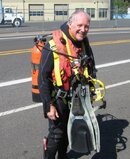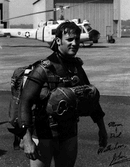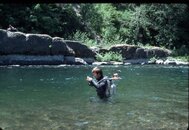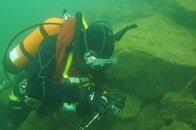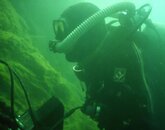Who trained Cousteau? Experience, much good, some bad, some downright nasty (one Cousteau diver did die, Maurice Fargues; Cousteau and Dumas almost died several times--Cousteau to oxygen poisoning from a rebreather before he developed the compressed air regulator and the two of them to CO poisoning in the Fountain of Vaucluse near Avignon, France). Gagnan did not do much diving; he was the engineer.I was lectured by the scuba police this weekend, given the typical lecture of “you are doing a very dangerous thing; you will die on your dive”. The reason for the lecture was that my scuba regulator did not meet their definition of a safe regulator.
I dive a Phoenix HPR Royal double-hose regulator. When I asked the scuba police why I was going to die and what was dangerous, the response I was given is that my scuba regulator is old. The scuba police gave no additional information to support their claim only that all double-hose regulators are old and unsafe...
...Who trained Cousteau and Gagnan? They invented the Scuba regulator. Am I not allowed to teach myself through studying and practice and eventually creating my own scuba system just like Cousteau and Gagnan did? If they spent the time teaching themselves, shouldn’t I be able to do the same and not get attacked for it?
I started diving in 1959, and was certified LA County in 1963. Between 1959 and 1963, I was learning on my own. My text? The Silent World, by Jacques Cousteau, and any other diving publication I could find. I must have read The Silent World three times. If you read it cover-to-cover three times, you'll get enough vicarious experience to avoid most of the "traps" that diving has in store. Add to that a set of dive tables from The New Science of Skin and Scuba Diving about the physiology of diving, associated reading, a depth gauge (my first was a capillary gauge--simple and almost fail-safe), and a watch, a good swimming/snorkeling background, and you have a fairly safe diver, even without certification.
I did also get certified by the U.S. Naval School for Underwater Swimmers in 1967, and as a NAUI Instructor #2710 in 1973. I wrote articles on buoyancy control and emergency procedures for NAUI News, and for the Sixth and Seventh International Conferences on Underwater Education (IQ6 and IQ7).
The "scuba police," those self-appointed "experts" on diving, really have no idea of how to learn anything. I am still learning, by procuring older equipment, figuring out how it works and how it doesn't, and writing about it. My most recent project was the Dacor Nautilus Constant Volume System (CVS), a BC that only needs one adjustment to keep a diver in trim throughout the dive. Usually they try to scare people into buying expensive gear, some of which is useful, some of which is redundant and originally used for deeper diving or cave diving (octopus regulator, pony bottle, redundant regulators on independent doubles, etc.), and some of which is to me ridiculous (double tanks with additional slung bottles) for normal diving. These divers don't know how to dive free. For someone such as me who helped develop buoyancy compensation concepts, today's emphasis on BCs (which now are more expensive than the scuba itself) shows ignorance of basic diving skills in favor of what we used to call "push-button diving."
Well, I'm only getting started, but it's getting late so I'll leave it at that.
SeaRat
PS, I've enclosed several photos, one in my current gear (with the Para-Sea BC I patented and never got sold) and one of me in parascuba gear from my time at the 304th Aerospace Rescue and Recovery Squadron, Portland Air Base, Oregon as a Pararescueman in about 1976. Note that in the 1976 photo, we did not use a SPG or BC during our parascuba jumps. I also added an experimental wet suit, with the BC built into the back by Bill Herder of Deep Sea Bill's, Newport, Oregon in the 1970s. This led to some of the back-inflation concepts when I demoed it at IQ6. I regularly dive my Mossback Mk3 regulator (much like your Phoenix) with my Para-Sea BC, here is Big Cliff Reservoir (photo by Sid Macken). Finally, Sid Macken, President of the Historical Diving Society, was diving with me in Big Cliff Reservoir with a Phoenix Aquamaster just like yours; was he an unsafe diver? I don't think so.




